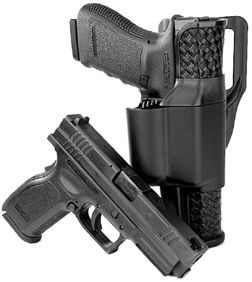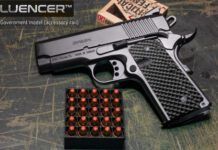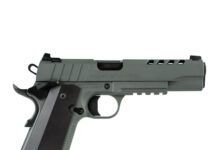
When asked why he carried a .45-caliber pistol, Texas Ranger H. Joaquin Jackson said, “Because they don’t make a .46.” Jackson, other law-enforcement professionals, and many consumers like the stopping power of a big round like the .45 ACP, and now they have an additional .45 — the .45 GAP — from which to choose.
Having tested the Glock GL37 in .45 GAP against standard .45 ACP guns and ammo (December 2004), we wanted to test another maker’s arm chambered for the GAP. The Springfield Armory XD 45 XD9504, $514, is the first pistol chambered for .45 GAP to be produced by a company other than Glock. In a twist on the December test, we pitted the XD against Glock’s full-size .45 ACPs, the GL21 and the ported-barrel GL21C. We challenged each pistol to fire quickly without fail and print tight groups at 25 yards. Here is what we found.
[PDFCAP(1)]
Springfield Armory of Geneseo, Illinois, imports the XD series of pistols from Croatia. This design is very close to, if not identical to, the 9mm pistol we tested in the April 2001 issue as the model HS2000. Springfield Armory first acquired sole importation rights for this model and later purchased rights to the design. The words HS Produkt Karlovac have been integrated into the Springfield Armory crest, found atop the slide.
The XD lineup includes pistols chambered for 9mm, .40 S&W, .357 Sig, and .45 GAP. Our XD 45 was a Service model with carbon-steel slide and stainless-steel barrel. A 5-inch model is also available, and options include a stainless-steel slide and an olive-drab green frame. The two supplied nine-round magazines featured polished stainless-steel bodies. The sights were big and bold, showing a three-dot design. Our first impression was that the sights were too open, showing a wide front sight surrounded by plenty of light, but they proved to be quick to find and easy to track. The sights front and rear were dovetailed into place, so making changes should be simple .
By including a safety in the face of the hinged trigger, the XD mimicked a Glock. This lever must be pressed for the trigger to move back and the gun to fire. One characteristic difference between the two actions is how much the striker moves to the rear as the trigger is pressed to the point of ignition. In each case movement of the slide preloads the striker, but not completely. When the XD was cocked, a pin could be seen extending from the striker through the rear of the slide, protruding about 0.05 inch. As the trigger was pulled, this safety indicator could be seen moving rearward an additional 0.01 inch before the shot broke, barely visible to the naked eye. Despite this movement, the XD 45 is considered to be a single-action pistol.
In comparison the Glock trigger does the job of moving the striker significantly further to the rear before release. As a result the Glock Saf-Action trigger is considered to be a double-action system only because the Glock trigger performs its two chores, that of setting the striker and releasing it, in a more obvious fashion.
Nevertheless, the XD 45 draws from at least two other designs distinguishing it from the Glock. Much like the Sigarms pistols, a block directly beneath the chamber provides lockup and barrel support. In the case of the XD pistol, this was the only point of metal-to-metal contact between the frame and slide. The rear of the frame employed polymer rails to regulate slide movement, but rails on either side of the support block bore most of the stress. To remove the slide from the frame required a routine similar to that of the Sigarms P-series design. After removing the magazine and emptying the chamber, you must lock the slide back. Then rotate the latch located on the left side just above the trigger guard clockwise 90 degrees. Next, release the slide until it stops slightly out of battery. Press the trigger and the slide will now move forward off the frame.
Each of the guns in this test utilized a linkless barrel design, and the top end consisted of barrel, slide and one-piece guide rod with captured spring. To replace the slide, apply it to the frame from the front and move it into the locked-back position. Rotate the latch counterclockwise and release the slide. At this point the gun is cocked and ready to fire. The XD 45 does not have a decocker. To relax the firing mechanism, we had to press the trigger. Making sure the magazine was out of the gun and there was visual confirmation of an empty chamber even during reassembly was the safest procedure.
Once loaded, two safety devices became apparent. The aforementioned striker extension protruded from the rear of the slide, and a loaded-chamber indicator that runs parallel with the bore popped up at the rear of the barrel hood. In reduced light these parts might be invisible, but running the trigger finger across the top of the slide is one safe way to check the condition of the chamber. The XD 45 also borrows from the Browning 1911 pistol because the gun will not fire without compressing the grip safety with the web of the strong hand. Together, this system is what Springfield Armory refers to as their Ultra-Safe Assurance, or USA, trigger.
Although the XD ejects to the right, the left-handed shooter has not been forgotten. The magazine release appeared on both sides as well as an indentation at the upper portion of the grip. A similar molding was found on the Glock pistols as well, and we thought it was especially useful for bracing the thumb during weak hand or strong hand only fire. The front strap offers a predominantly flat surface, but the rear strap was fashioned with a palm swell. A grip pattern similar to checkering was molded into each of these surfaces with a pebble finish on the sides of the grip. Our staff felt that the XD offered a very natural grip to the shooter.
To test the gun’s operation, [PDFCAP(2)] of 200-grain Speer Lawman .45 GAP full-metal-jacket ammunition, 230-grain Winchester Ranger JHPs, and two varieties of Speer Gold Dot Hollow Points with bullets weighing 185 grains and 200 grains respectively. The .45 GAP cartridges were shorter front to back than .45 ACPs, and the GAPs utilize a small pistol primer instead of the larger cup, but power and recoil are comparable. Despite our XD 45’s sporting a 4-inch barrel, we registered muzzle energy above 425 foot-pounds in three of four test loads. Only one of the test rounds fired from the 4.6-inch-barrel .45 ACP pistols approached this power.
From the bench we found that due to the short dust cover, setting up the XD 45 on sandbags was more difficult than working with a true full-size pistol. But we also found that the single-action trigger helped us concentrate because we didn’t have to steer the sights over the course of a long trigger press.
We like to see groups averaging less than 3 inches across and closer to 2.5 inches. We were able to achieve this level of accuracy with both the 200-grain Speer Lawman FMJ rounds and the Winchester Ranger JHPs.
[PDFCAP(3)]
The 21 was Glock’s biggest gun until the arrival of the models 34 and 35, which feature a longer slide and 5.3-inch barrel. The .45 ACP 21 incorporates a 4.6-inch barrel, but at about 27 ounces unloaded, it is still the heaviest pistol in the Glock lineup. This is the result of beefing up the original design to handle the pounding of .45 ACP ammunition. For example, the current 9mm Model 17, which is similar in dimensions to the GL21 and closest in design to the original Glock pistol, weighs only about 22 ounces. Our GL21 arrived with two 13-round magazines.
Palm swells and finger grooves with helpful checkering molded into place have helped the Glock pistols become more shooter friendly, and adding a rail to the dustcover allows accessories to be added easily. The magazine release is prominent, making reloading faster. The extractor offers plenty of surface area to the case rim and serves as a loaded-chamber indicator, sticking out just enough to tell the shooter visually or by touch when the gun is charged.
Removing the top end still requires a firm claw-like grip. The routine is to move the carbon steel slide to the rear about a half-inch and pull down on the locks located just above the trigger guard on each side of the frame simultaneously. This allows the slide to move forward. We think the locks could be more pronounced and easier to grab without subtracting from the snag free profile or increasing the likelihood of being activated unintentionally.
Once the top end was removed, the difference in weight between the feather-light receiver and the slide became apparent. The polymer guide rod and flat coil spring stayed together as one unit, so there were no small parts to misplace. Just a receiver, carbon-steel barrel, slide, and recoil assembly. The top end rode on four small guides that are inserted into the polymer rails of the receiver. Putting the gun back together merely required applying the top end to the frame.
The Glock design does not include a decocker, so making the gun safe after a string of fire required pressing the trigger, but only after removing the magazine and confirming that the chamber was empty. If you are used to a 1911, which can be shut off by activating the thumb safety, you may feel uneasy putting this gun down on the bench in a loaded condition. If you are in the habit of picking up a gun from the bench with the finger inside the trigger guard or think that the trigger face is part of the grip surface this gun (or any other) is not for you.
Our GL21 and GL21C pistols each arrived with a heavy trigger that provided about 10 pounds of resistance. We expected a 5.5-pound pull. At the range the large size of the gun made it easy to shoot from a sandbag rest. The weight of this trigger and the amount of take-up let us approach the trigger almost like a two-stage mechanism. But this technique was too dangerous to attempt anywhere else but from the shooting bench.
For collecting accuracy data, we fired Winchester 230-grain FMJ ammunition as well as 200-grain JHP/XTP rounds from Hornady and Winchester’s 185-grain Silvertip hollow points. The Hornady ammunition proved the most powerful, moving at an average velocity of 1007 fps. Both the Hornady ammunition and Winchester FMJ rounds produced average groups measuring about 3 inches across. The Winchester Silvertips proved to be the best choice with groups ranging from 2.1 to 2.8 inches. We had no malfunctions.
[PDFCAP(4)]
The model 21C was identical to the 21 save for the two ports in the barrel placed 45 degrees apart at approximately 10 o’clock and 2 o’clock in relation to center bore. The placement of the ports didn’t allow gases to blow out and obstruct the front sight, which consisted of a large white dot. Also, the dot remained clean and visible. The rear sight was a standard notch with white outline. Our test shooter said that he never saw the white U-shaped outline detailing the rear notch while he was shooting.
Porting redirects some of the gases propelling the bullet down the barrel to work against upward movement of the pistol. The desired effect is recoil control, and improved follow through, both in terms of grip and tracking the movement of the front sight. The negative effect is the increase in noise level. The GL21C was louder than the non-ported model, but not by as much as we had expected. This was partly because the .45 ACP round is not a high-pressure round like the .357 Sig, for example.
Looking at our accuracy and chronograph data, the average loss of velocity due to porting ranged from 22 fps to 41 fps. The Hornady JHP/XTP +P rounds were the hottest .45 ACP rounds in the test. Although they lost the most velocity when fired from the GL21C, they also offered the most gain in control, proving that the porting had worked as intended. Despite a single 3.2-inch group, we were able to reduce average group size by a full half-inch compared to results from the non-ported GL21. There was no doubt that the porting added control and comfort to our range sessions. For those shooters who typically cannot withstand the recoil of .45 ACP ammunition in a light pistol, we think the GL21C will be a pleasant surprise.
Gun Tests Recommends
• Springfield Armory XD 45 XD9504 .45 GAP, $514. Best Buy. Given a simple equation of power per dollar, we’re not sure you can beat this pistol. The .45 GAP was made for the polymer pistol, and in our opinion, the XD offers one of the most natural-feeling grips to be found. We would still like to see a thumb safety, but the “beavertail” grip safety helps.
• Glock GL21 .45 ACP, $679. Buy It. This is one beefy gun, but if you started with a Glock or a DAO pistol and prefer not learn a whole new system, then the GL21 is a good choice in a full size pistol.
• Glock GL21C .45 ACP, $709. Our Pick. The porting reduces recoil at the cost of more noise and introduces some concern about avoiding the gas ports. But the result is you don’t have to be a linebacker to deliver 14 rounds of legendary stopping power. Also, we felt the ports contributed to accuracy when shooting defense rounds.




























